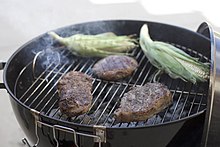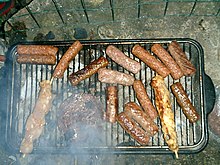Grilling
- For the device used to cook see Grill (cooking), for other uses see Grill. See also: Barbecue.

Grilling is a form of cooking that involves direct heat. Devices that grill are called grills. The definition varies widely by region and culture.
In the US and Canada
In the United States and Canada, use of the word refers to cooking food directly over a source of dry heat[1], typically with the food sitting on a metal grate that leaves "grill marks." In the UK and other Commonwealth countries this would be referred to as barbecueing, although grilling is usually faster and hotter than the American sense of the word "barbecue," which does not necessarily imply grill marks. Grilling is usually done outdoors on charcoal grills or gas grills, a recent trend is the concept of infrared grilling. Grilling may also be performed using stove-top "grill pans" which have raised metal ridges for the food to sit on, or on an indoor electric grill.
Similar to a grill/broiler is a "salamander", which is most frequently used in a professional kitchen. It is smaller than a standard grill/broiler, and is used to finish off dishes, such as caramelizing the sugar on a Crème brûlée.
The flame-grilling machine at Burger King restaurants is called a 'Broiler' in the US. It works by moving meat patties along a chain conveyor belt between top and bottom burners, 'grilling' from both sides.
In 1898, the Bridge & Beach Manufacturing Co., St. Louis, MO., started manufacturing a vertical cast iron stove. These stoves were designed so that the meat could be flame-broiled quickly from both sides of the stove at the same time. Hinged steel wire gridirons were designed for use in the vertical broilers to hold the meat in place while it cooked. The gridirons were slid in and out of the stoves like modern day oven racks and the stoves took up a small amount of counter space. These stoves were used in lunch wagons to feed factory workers.
A skewer or brochette, or a rotisserie may link smaller portions of food into this process. The resulting food product is often called a kabob or kabab or satay.
Mesquite or hickory wood chips (damp) may be added on top of the coals to allow a smoldering effect that provides additional flavor to the food. Other hardwoods such as pecan, apple, maple and oak may also be used.
What gives grilled meat the taste is a chemical process called the Maillard reaction. This process is the term for the browning of meat. The Maillard reaction, along with the flavors imparted by a wood or charcoal fire, is what sets grilling apart from other methods of cooking meat.
Barbecue and barbecuing are a way of cooking meat using the indirect heat and smoke from a wood or charcoal fire in a barbecue pit or smoker. Barbecuing is the slow smoking of tough cuts of meat. Grilling is a method of cooking more tender meats using the direct heat of a fire with the meat over the fire.[1]
For example, a beef brisket is a meat cut often hot smoked or barbecued at 240-270F for 8 to 12 hours. A brisket is not a cut of beef that lends itself to being grilled.
Two of the largest manufacturers of backyard grills in North America call their products 'grills' and not barbecues. See www.charbroil.com or www.weber.com.
Infrared grilling is a new method among grilling enthusiasts, using direct heat from propane or natural gas it heats the food directly at temperatures over 900F. Also called Sear-Grilling. With extreme temperatures the food is instantly seared to lock-in juices, making the food more flavorful.
In the UK
In the United Kingdom and Commonwealth countries (except Canada), grilling generally refers to cooking food directly under a source of direct, dry heat. The "grill" is usually a separate part of an oven where the food is inserted just under the element.[2] This practice is referred to as "broiling" in North America. In electric ovens, grilling may be accomplished by placing the food near the upper heating element, with the lower heating element off and the oven door partially open. Grilling in an electric oven may create much smoke and cause splattering in the oven.[3] Gas ovens often have a separate compartment for grilling, as a drawer below the flame.
In Asia
In any Japanese city a yakitori cart or shop with charcoal-fired grills and flavorful marinated grilled meat on a stick can be found on many streets. The meat is grilled directly over hot charcoal coals at high temperature. The same can be found in most Asian countries, such as China and Korea, many use a small charcoal grill to cook meats and vegetables. In Malaysia, Singapore and Indonesia, a favorite food item from food vendors is the famous Satay, marinated meat on a bamboo skewer grilled over a charcoal fire and served with peanut (sate) sauce.
Direct and indirect cooking


There are two methods to grill food over a gas, wood, charcoal, or infrared - direct or indirect cooking. For the devices used to grill see Grill (cooking).[4][5] Using the direct heat method, the food item is placed directly over the flame or coals. This method exposes the food item to very hot temperatures, often in excess of 500F or 900F for infrared grills. This is the fastest way to cook food items on a grill. The food items are cooked by the flames and radiant heat coming from the heat source of the grill. The direct heat method is used for grilling steaks, hamburgers, hot dogs, sausage, pork chops and skewers. The food items must be carefully monitored so as to not burn them.
Using indirect heat, you place the food item so that it is not directly over flames or coals. This is done by having the fire or coals on only one section of the grill and placing the food item on a part of the cooking grill opposite the flames or coals - for example, having the burners going on the right side of a gas grill but off on the left side or placing the coals on the right side of the grill and no coals on the left side. In a charcoal grill, when indirect grilling it is best to place a foil pan of water under the food to keep it from drying out. Using the indirect grilling method is best for large cuts of meat or bone-in poultry. It allows the food to cook all the way through without burning or charring on the outside of the meat.
Cooking meat at high temperatures, such as broiling/grilling or barbecuing, can lead to the formation of heterocyclic amines, which are carcinogens[6].
Flattop grilling
A flattop grill is a cooking appliance that resembles a griddle but performs differently because the heating element is circular rather than straight (side to side). This heating technology creates an extremely hot and even cooking surface, as heat spreads in a radial fashion over the surface.
The first flattop grills originated in Spain and are known as planchas or la plancha. Food that is cooked “a la plancha” means “grilled on a metal plate.” Plancha griddles or flat tops are chrome plated which prevents reaction with the food. Some base metal griddles will depart a subtle flavor to the food you're cooking. Also, with a planch if you use a low even heat and a drop of oil you can toast the food and carmelize some of the natural sugars in the food. For example, Filetes a la plancha translates to Grilled Beef Fillets. You will also find many la plancha recipes in Cuisine of Chile and Cuban cuisine.
The flattop grill is a versatile platform for many cooking techniques such as sautéing, toasting, steaming, stir frying, grilling, flambé and roasting. In addition, pots and pans can be placed directly on the cook surface, giving more cooking flexibility. In most cases, the steel cooksurface seasons like cast iron cookware, providing a natural non-stick surface.
Commonly grilled food and cooking methods

- Steaks
- Hot Dogs
- Hamburger patties, cube steaks
- Sausage
- Chicken breasts
- Chicken thighs and legs
- Pork Chops
- Fish
- Shrimp
- Asparagus
- Potatoes
- Kebabs
- Fruits
- Mushrooms, edible mushrooms, portobello mushrooms
- Squash
- Sweet corn, corn on the cob
- Vegetables, root vegetables
Etymology
The word grill refers to the grid of wire (rack) that food is prepared on, whether it be with the heat from above or below.
References
- ^ a b "License to Grill", Schlesinger and Willoughby, William Morrow and Co. 1997
- ^ http://en.wikibooks.org/wiki/Cookbook:Grilling
- ^ Howstuffworks. "In a kitchen oven, what is the difference between the bake setting and the broil setting?" Last accessed April 15, 2007. http://home.howstuffworks.com/question228.htm
- ^ About Barbecue
- ^ Welcome to Weber.com
- ^ Sugimura T, Wakabayashi K, Nakagama H, Nagao M (2004). "Heterocyclic amines: Mutagens/carcinogens produced during cooking of meat and fish". Cancer Sci. 95 (4): 290–9. doi:10.1111/j.1349-7006.2004.tb03205.x. PMID 15072585.
{{cite journal}}: CS1 maint: multiple names: authors list (link)
- Elliott, Richard Smith (1883). Notes Taken In Sixty Years. R. P. Studley & Co.
- Riccio, Anthony V. (2006). The Italian Experience In New Haven : Images And Oral Histories. SUNY Press. ISBN 0-791-46773-2.
- Romaine, Lawrence B. (1990). A Guide To American Trade Catalogs 1744-1900. Courier Dover Publications. ISBN 0-486-26475-0.
